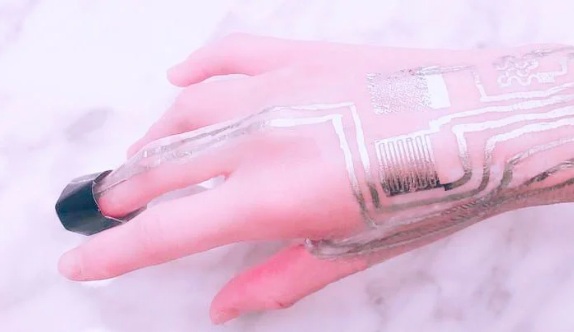
- 2020-10-26
- 0.0 Reitingas
- 610 Peržiūrų
- Aptarti
Wearable sensors are evolving from watches and electrodes to flexible devices that provide much more accurate biometric measurements and user friendliness.
Now an international team of researchers has taken evolution one step further by printing sensors directly onto human skin without using heat.
Led by Larry Cheng, a professor at the Pennsylvania Department of Engineering and Mechanics, the team published their findings in ACS Applied Materials & Interfaces.
“In this article, we report a simple yet universally applicable fabrication technique using a new sintering promoter layer to provide direct printing for sensors on the body,” said Lin Zhang, a researcher at the Harbin Institute of Technology in China. and in Cheng’s laboratory.
Cheng and colleagues have previously developed flexible printed circuit boards for use in wearable sensors, but printing directly onto the skin is difficult due to the process of bonding the metal components of the sensor. This process, called sintering, usually requires a temperature of about 300 degrees Celsius to bond the sensor silver nanoparticles together.
“It is obvious that the surface of the skin cannot withstand such high temperatures,” Cheng said. “To get around this limitation, we have proposed an auxiliary sintering layer – something that does not damage the skin and can help the material to sinter at a lower temperature.”
When nanoparticles are added to the mixture, the silver particles are sintered at a lower temperature, about 100 C.
“This can be used to print sensors on clothing and paper, which is useful, but it’s still higher than what we can handle with our skin,” Cheng said, noting that around 40 C could still burn skin tissue.
“We changed the formula of the auxiliary layer, changed the printing material and found that we can sinter at room temperature.”
The room temperature caking layer consists of a paste of polyvinyl alcohol, the main ingredient in removable face masks, and calcium carbonate, which contains eggshells.
This layer reduces the roughness of the print surface and allows the creation of an ultra-thin layer of metallic designs that can bend and fold while maintaining electromechanical capabilities. When the sensor is printed, the researchers use an air blower, such as a hair dryer, set to cool to remove water that is used as a solvent in the ink.
“The result is impressive,” Cheng said. “We don’t have to rely on heat for sintering.”
The sensors are able to accurately and continuously record temperature, humidity, blood oxygen levels and heart signals, Cheng said. The researchers also connected sensors on the body into a wireless network to track the combination of signals as they travel.
The process is also environmentally friendly, Cheng said. The sensor stays strong in cool water for several days, but a hot shower will easily remove it.
“It can be recycled,” Cheng said. “And last but not least, the removal does not damage the skin either. This is especially important for people with sensitive skin such as the elderly and babies. The device can be useful without placing additional stress on the person using it or the environment. ”
The researchers then plan to change the technology for specific applications as needed, such as a precise network of sensors on the body deployed to track specific symptoms related to COVID-19.
Pasaulio naujienas kitaip... skaitykite Paranormal Telegram, FB ir X(twitter) kanale...kadangi jau perskaitėte šį straipsnį iki pabaigos, prašome Jus prisidėti prie šio darbo. Skaitykite „Paranormal.lt“ ir toliau, skirdami kad ir nedidelę paramos sumą. Paremti galite Paypal arba SMS. Kaip tai padaryti? Iš anksto dėkojame už paramą! Nepamirškite pasidalinti patikusiais tekstais su savo draugais ir pažįstamais.
Turite savo nuomone, tapk autoriumi, prisijunk ir rašykite bloge. Dalinkitės receptais, sveikatos patarimais, nutikimais, susidūrėte su nekasdieniškais reiškiniais. Galite išversti iš užsienio kalbos, talpinkite su nuoroda. Laukiame Jūsų straipsnių, naujienų, apžvalgų ar istorijų!
Susijusios naujienos
Būkite pirmi, kurie pasidalins savo nuomonėmis su kitais.
Skaityti daugiau
Skaityti daugiau
Skaityti daugiau
Skaityti daugiau
